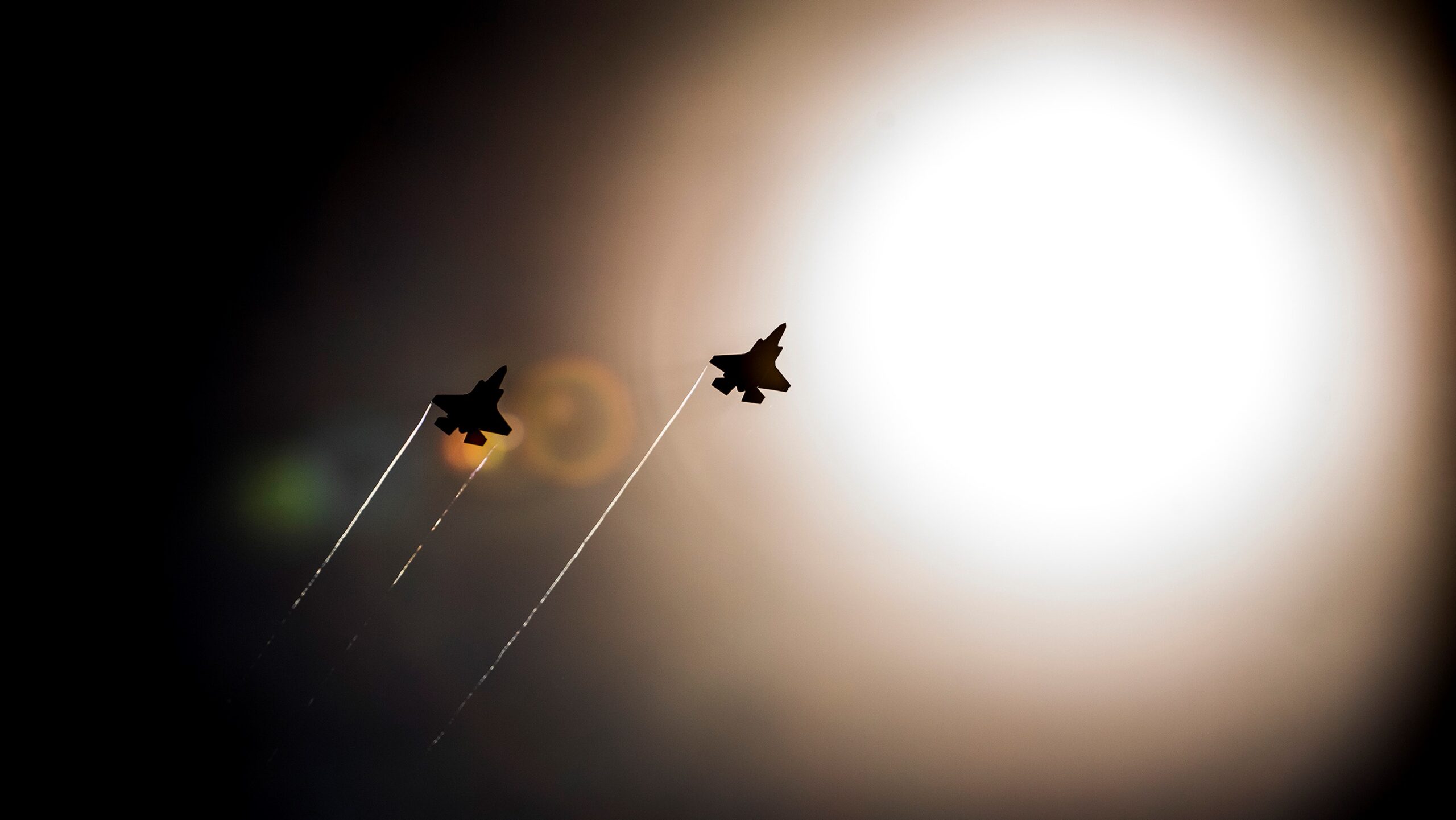MICHAEL MARROW

A pair of F-35 Lightning IIs pass under the sun while doing maneuvers to the Eglin Air Force Base runway. The 33rd Fighter Wing-owned aircraft is a fifth-generation fighter and used to train pilots and maintainers. (US Air Force / Samuel King Jr.)
WASHINGTON — The commander of the Air Force’s new Spectrum Warfare Wing recently warned that the US is “behind” its rivals when it comes to electronic warfare (EW), and said he needs more people, and a better way to train them, to improve the service’s non-kinetic weapons.
“In a lot of ways we gave our pacing challenges a big head start, [and] we gave ’em a bigger one in the spectrum,” Col. Joshua Koslov said Wednesday at an event organized by the Air and Space Forces Association, prefacing his comments by stating his wing “wear[s] a tab that says 2027 to impress upon us how close the threat is.” (2027 is the year US intelligence says Chinese President Xi Jinping wants his military to have the capability, if not the intent, to invade Taiwan.)
Koslov added “so we’re behind, and so it’s gonna take a everyone approach to really realize the full vision of what the future of the Spectrum Warfare Wing can be.”
In congressional testimony today, Navy Adm. John Aquilino, the commander of US Indo-Pacific Command, highlighted the importance of the spectrum.
“We view it through this lens of decision superiority, which means we need to be able to operate in contested space,” he told lawmakers. “We need persistent battlespace awareness of all things going on. We need to be able to close our kill chains with weapons and the network that allows that to happen, and the electro-magnetic spectrum is critical to that.”
Right now, Koslov said the wing, which is tasked with developing EW capabilities, is constrained by a focus on training airmen on specific platforms, imperiling the service’s ability to adapt to new technology as the Air Force eyes junking aging platforms, like older fighter jets.
“I worry that sustaining the wing is going to become hard from a personnel perspective,” Koslov said at an event hosted by the Air and Space Forces Association Wednesday. “We build electronic warfare officers based on platforms … when that’s not the best way to do that. As we divest platforms or divest crew members off of platforms,” he continued, “your pool of electronic warfare officers gets a lot smaller.”
Retaining those skills is critical for bolstering the 350th Spectrum Warfare Wing housed at Eglin Air Force Base, Fla., which Koslov said is also short on crew and the facilities that can accommodate them.
“I don’t have enough people. I don’t have the right facilities. And we’re working with the Air Force and [Air Combat Command] to get there,” he said. Currently, the wing is short “over” 200 military and civilian personnel each, vacancies Koslov characterized as “good” because it shows the wing can grow beyond the “50 more seats to give in the facility that I have today.”
The wing, activated in 2021, has yet to achieve full operational capability, Koslov said, which he added would come once the wing’s forthcoming third contingent, the 950th Spectrum Warfare Group, is stood up. (The wing currently consists of two groups, the 350th Spectrum Warfare Group and the 850th Spectrum Warfare Group, according to the wing’s website.)
Work is under way on bringing that new group to fruition, and according to an Air Force press release, its headquarters at Robins Air Force Base, Ga., is expected to be activated in fiscal 2027.
In his talk, Koslov did say he’d expect the Air Force and Navy to be “carrying the burden” in the event of a clash in the Indo-Pacific theater. And as it is, some key capabilities are missing.
“We’ve got to have an ability for if the Air Force or the Navy develops a waveform against target X, that it can get validated and verified and passed through the guts of the system and into Air Force systems faster than we have today. Because it doesn’t exist today,” Koslov said.
The F-35 Project
One of the wing’s many assignments, carried out specifically by its 350th Spectrum Warfare Group, is reprogramming all assets in the Air Force, along with “every single F-35 in the world,” Koslov said. With three variants across the Air Force, Marines and Navy, along with an enterprise of 17 countries that is slated to grow, the Joint Strike Fighter is representative of the challenge the wing has to meet for creating an accessible data architecture that can benefit a range of platforms, he added.
“If I could solve the F-35, I can pretty much solve this whole problem,” he said, cautioning “that’s not 100 percent true.
“The F-35 is a coalition platform. It’s a joint platform, and it’s an acknowledged SAP’d up platform,” he said, referring to Special Access Programs. “So if I can use F-35 data down to like a secret level system, I’ve solved a lot of my challenges, specifically with the new stuff that the Air Force is buying coming down the road.”
With the Air Force keen on fielding families of systems that can be connected across all domains, Koslov pointed out that fielding a particular capability won’t cut it if it can’t be leveraged by the joint force.
“It’s not enough to buy a capability. You have to know how to employ that capability with the rest of the joint force in order to achieve the joint force commander’s objectives,” he said. “And we can do that today in the spectrum.”
No comments:
Post a Comment